
APPLY NEW KNOWLEDGE
How your new transparency becomes an everyday benefit
Setting up and expanding a functioning reporting system is one thing, using it correctly is another. Many reports are often designed for individual questions and then regularly updated - even though the actual question has already been answered or completely new questions are pending. The result is a flood of business reports that offer a large number of key figures and information that go beyond current requirements.
But do the reports really fit the basic company strategy?
Do the target/actual analyzes help to map your business flexibly and enable you to look ahead?

The challenge of reporting
Companies often have a large number of reports, lists and formulated reports. In many cases, however, a lot of effort is in vain, since only a report that is read is worthy of its work. The work is properly respected when the reports are not only read, but also used in the decision-making process for which they were originally intended. A target / actual comparison according to sales areas and product categories quickly comes into conflict with marketing expenses if there are deviations from the planned figures. Most of the time these are quietly accepted and "corrected" with the next planning figures. This is exactly where we start. Depending on the case, annual planning is simply no longer modern enough. The target figures for December of the following year are usually "rolled" more than 14 months in advance than actually determined. A rolling planning system can also be implemented economically for most medium-sized companies. As a result, you too can benefit from being able to recognize the effects of short-term changes in delivery times and prices at an early stage. In this way you remain in possession of your ability to react and retain or regain the ability to make decisions known from the past.
Related topics
-
Controlling & Reporting
on the subject -
Interimsmanagement
on the subject -
Mandatory sustainability reporting
on the subject -
blog posts
on the subject








